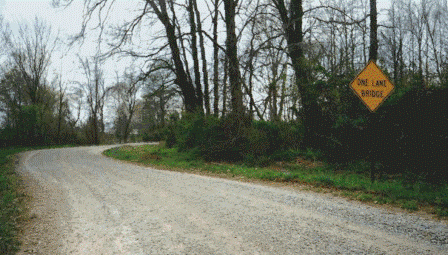
Old road leading to a one-lane bridge at Stoney Point.
Thriving on the Old Southwest Trail
By CLAUDE E. JOHNSON
Arkansas Gazette, November 17, 1946
When is a town not a town? That is a question that has baffled White County tax assessors for the past 88 years, or to be more exact, ever since Old Stony Point, located five miles west of Beebe, failed to develop into the thriving little city that Dr. D.P. Coffey and H.B. Strange hoped for when they surveyed into town lots in 1858.
Stony Point was quite a little village then. There were several stores, a blacksmith shop, and perhaps a saloon. The first buildings had been erected some 20 years previous as way stations for the east or lowland branch of the old Batesville and Little Rock road, which had succeeded the western or highland branch which was being abandoned because of the steep, rough Des Arc mountain.
This western or main line of the Old Southwest Trail had been in use by Indians for centuries before white men found it. But the road was not to be abandoned until after President Jackson had appropriated $60,000 for its improvement through Arkansas, during the five years preceding Arkansas’ entry into the Union in 1836. The road was made nearly a direct line to Little Rock from Britton’s Ferry on Red River, two miles north of Searcy, and thus cut across the worst mountain in this section of the state. There were no villages or towns along the route, so years later when the route was changed to a more southeasterly direction from Searcy to circumvent the hills, Stony Point arose from a two-room log inn to a village, as the first of kits kind between Batesville and Little Rock, unless perhaps Old Austin flourished at about the same time.
From the time that Dr. Coffey and Mr. Strange surveyed the town into one-acre lots in 1858 until a few years after the Civil War, Stony Point was to play an important part in the history of Arkansas. Had it not been for the Cairo and Fulton Railroad which crossed White County in 1870-72 and missed Stony Point about six miles, it probably would still be a leading spot in this section of the county.
Instead, Beebe was to spring up and overshadow it because of the railroad. Few histories mention the town, but tradition has it that armies of both sides encamped here during the Civil War, and that the businessmen enjoyed a war boom somewhat similar to ours today. When Beebe was incorporated April 15, 1875, the majority of Stony Point merchants were ready to remove their savings and help establish the new railroad town.
Jim Walker, one of the town’s last of the early settlers, who died in Beebe a few years ago at near 80 years of age, said that in the years just before and right after the Civil War, Stony Point had a population of around 500 people and that the town consisted of several stores, a saloon, post office, Masonic Hall and two or three blacksmith shops. There was also a grade school, which was made into an academy, under a teacher named Sam Apple, who with his sister Sally taught there several years. The school was operated by subscription because free schools were not introduced until 1872.
Mr. Walker enjoyed reminiscing of his early childhood. He said the high points of the years was when he was allowed to accompany his father and other men on their trips to and from Little Rock in the old freight wagons, loaded with cattle or other country produce on the way down and whatever merchandise they could buy to bring back. It usually took several days to make the round trip.
Today Stony Point is one of the quietest, least heard of communities in White County. It is a prosperous farming community where everyone attends to his own business, peaceably. The only old building left of the original town is the present home of Mr. and Mrs. Will Fecher, who live in the old Dr. Janes’ home. He was the leading doctor of the community until about 1870. The old cemetery has many tombs marking the graves of the early settlers, but tombstones do not tell a story by themselves. The little white church standing nearby lends its dignity to the scene of White County’s only ghost town.
(The author was president of the White County Historical Society in 1970 and 1971. He consistently spelled the community Stony Point but in recent years it has also been recognized as Stoney Point.)